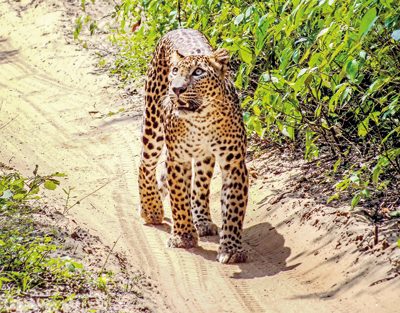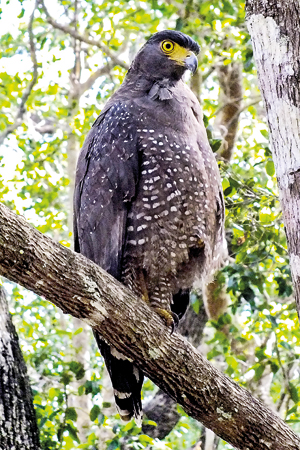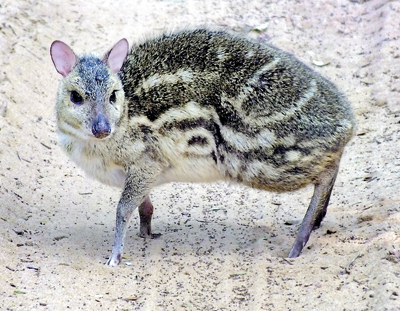When the ‘land of the leopard’ lived upto its name

A purposeful stroll: Eight leopards in four days!
The thrill of an impending safari never seems to wane, although one may have been through the familiar routine many a time before. It was no different this time either when my partner in crime, cousin Ajit broke the happy news that he would be in Sri Lanka in January this year. The ensuing visit to the Department of Wildlife was fruitful as I walked out with Manawila Bungalow booking safely under my belt.
Wilpattu-bound, we were making haste on the Puttalam-Anuradhapura road, when just past Karuwalagaswewa I received a call from Ajith of Eagle Safaris’. “Sir Borupanwila pataw balanna puluwan. Muwek allan thiyenawa. Ikmanata enna!” Magic words indeed! We were at the park office of Wilpattu National Park in no time and picking up our tracker, an eager youngster, Tharaka, we headed there.
Borupanwila, is readily identifiable by the prolific growth of tussocks of a type of grass like plant used in Ayurvedic medicine called “Borupan”. We had gleaned that the kill was at a small water hole called Viradawila, in that vicinity. Taking the turn to Viradawila, we saw two rows of vehicles trying their best to spot the leopard which was to the right of us. A couple of them, in their over enthusiasm had got bogged down in a mushy area of the jeep track. The revving of the engines in their attempt to get out of the bog didn’t help much with observing leopard. The kill, a young doe, was clearly visible about 50 yards away from the jeep track.
A little distance away, well camouflaged in the undergrowth with their rosettes being distinctly visible, lay the mother leopard and her two sub adult cubs – the Borupanwila clan. Her heaving flanks and sporadic twitch of her tail told us that she was trying to get some sleep after a full meal, but was unable to do so due to the mayhem created by her enthusiastic fans. Knowing fully well that she was not going to show herself for a long time and not wishing to add to her discomfort, we opted to head for Manawila.
As dusk steadily settled over Wilpattu, the familiar night sounds of the jungle were like a soothing chorus to our ears. Peace reigned supreme broken only by the occasional alarm call of sentinel spotted deer in the distance. The ‘chuk-chuk-chukoor’ of the night jar and ‘crick, crick, crick’ of undisturbed frogs were the only other audible sounds, except for the sound of happy human voices. The resident herd of spotted deer drew nearer the bungalow and settled down for the night.

Up close: A Crested Serpent Eagle
Early next morning, after a hot cup of coffee, we all piled into the jeep for the morning’s safari determined to make amends for the lost opportunity of the previous evening. Not too far from the bungalow, we came across the fresh spoor of a leopard. The pug marks were those of a smallish animal, probably a female. She had strolled right along the main road, leading away from the bungalow for a fair distance, most likely in the wee hours of the morning. But the drive through the park for the next hour and a half was fruitless. Disappointment was just setting in, when we turned into Kokkarivillu Uda Para.
All of a sudden we were sitting on the edge of our seats, for there right in front of us were around ten jeep loads of people totally engrossed in the action unfolding in the shrub jungle to the right of us. The tracker’s voice dropped to a whisper as he uttered ‘kotiya’ and pointed in the direction of a dried branch of a dead sapling a few yards from the road. Framed in the lens of my video camera was the mischievous countenance of a large male leopard. His keenly observant eyes looked back at me searchingly as if saying, “this is my domain, so I call the shots here”. He kept looking intently at a spot a little to his left. There sprawled on the dry leaf litter was another leopard. Her smaller face told us that she was a female. Her unflinching gaze was a sight to behold. Over 60 people were mesmerized; moving only to relieve an aching muscle or to improve the angle of their camera.
A movement behind the two leopards caught my attention. A third leopard which had lain unnoticed all this while, then decided that “nuff’s nuff” and got up from her concealed position to slink away into the brush behind her. This was a signal for the others to move on. This, they did, leaving a spellbound group of wildlife enthusiasts replete with the joy of having had the good fortune to experience such a thrilling morning. We later leant that this trio was the Nelumwila Clan. The presence of a big male with two females defied logic, though, according to leopard guru Rukshan Jayewardene, this is not an entirely uncommon form of bonding between leopards at Yala National Park.
The spell of good luck that we were blessed with that morning was not quite over. Right in the middle of the path of the jeep, crouched on the sand was that most elusive of Sri Lankan wildlife, a cute ‘meeminna’ or mouse deer. Usually a nocturnal shy little animal possibly more difficult to observe in the wild than even a leopard, it appeared to be hypnotized and unable to flee, for this is its usual reaction when confronted by a perceived threat. Frozen with fear, the tiny fellow gave us ample opportunity to photograph it to our hearts content.
Wilpattu National Park renowned in the ‘60s and ‘70s as the best place in the world to observe the leopard is also steeped in history. Our visit to Kudiramalai confirmed this in no small measure. Kudiramalai is undoubtedly the cradle of the Sinhala race. I gazed at the aquamarine waters of Portugal Bay and lapped up the splendour and serenity of the terrain that is unique to Kudiramalai. The white sands of Wilpattu gradually give way to the red sands of Kudiramalai. As one proceeds, the vegetation becomes stunted, Bonsai-like, as the trees and shrubs bravely cling on to life in the face of forceful winds. Occasional clusters of grayish rock are surrounded by pitted red pigmented rock formations and these in turn gather in large mounds forming bigger hillocks, the likes of which are not found anywhere else in the island.
My mind’s eye took me back to 543 B.C., when Prince Vijaya of India and 700 of his followers landed here. The coppery red soil around the area inspired Vijaya to name this spot “Thambapanni”.

‘Meeminna’ or mouse deer: Frozen with fear
Legend has it that one of Vijaya’s men, in search of human habitation, wandered off after a dog and never returned from the jungle. This fate befell every member of Vijaya’s entourage. Finally, it was Vijaya’s turn, and his foray into the wilderness brought him in contact with Kuveni, the Queen of the Yakkhas. Close to Kalivillu, en route to Kudiramalai, one comes across four of five stone pillars. These ancient structures of architecture are said to be the ruins of Kuveni’s Palace.
It is also recorded by Roman philosopher, historian Pliny, that around 44 A.D., a tax collector of the Government of Roman Emperor Claudius Caesar, was blown off course and ended up in the Port of ‘Hippuros’. This was the name the ancient Greeks had given Kudiramalai. A Malabar Queen Alli Rani, had ruled North and North Western Sri Lanka from the capital city of Kudiramalai. She is supposed to have despised men and all her warriors had been women. A true Amazon Queen indeed. She was known to have had a soft corner for pearls and horses. Pearls were plentiful in the surrounding seas. Alli Rani exchanged these pearls for Arabian horses. So, was born the legend of the horse mountain “Kudiramalai”.
To the west of the park abutting the now controversial Pallekandal church, lie the rolling plains of Pomparippu. In 1687, Catholic Missionary, Joseph Vaz visited Pallekandal and built a little chapel. Through the years it steadily grew in proportion to become the prominent church it is now. Pomparippu is best known for two reasons. It is an ancient archaeological site where a pre-Vijayan burial ground containing sealed urns holding human remains have been discovered. The other reason for its fame is the presence of elephants at any given time of the day, much like at Lahugala or Minneriya. It is home to a few large tuskers too. We were lucky enough to see two very young tuskers in a herd of six.
Our final morning and I was the only one on safari, the others opting to sleep late and take things easy while getting ready for the inevitable trip back to Colombo. We were at Mahapatassa. All of a sudden, the hoarse “kharr” “kharr”, the alarm call of a barking deer rent the air, prompting the tracker to say rather anxiously, “weli muwa kae gahana paththata yamuda?” In a trice we were at the spot where the barking deer had sounded its alarm, and there imprinted in the sand, were the fresh pug marks of a leopard, but it was gone. I cursed my bad luck. Disappointed, we drove back to Manawila, much to the joy of my companions who had given me strict instructions to be back in the bungalow by 9 o’clock, the latest.
The mid-day heat of the dry zone and the reassuring purr of the jeep as it comfortably negotiated the rugged roads of Wilpattu had made me dozy. The tracker’s agitated thump, jolted me out of my reverie. Lying on the main Kumbukwila-Mahapatassa road, was the most gorgeous female leopard one could wish to see. Facing us with her paws stretched out in Great Dane fashion, was Cleopatra, or so my friend Tony enlightened me subsequently. She was all the while looking hard at a clump of trees close by. Her mint green eyes gleaming in the filtered sunlight, she rose up and sat on her haunches facing away from us. She commenced grooming herself, whilst contemplating her next move.
The advent of another vehicle from the opposite direction quickly made up her mind for her; whipping around, she faced us again. A few steps forward, and in a flash she disappeared, leaping effortlessly into the trees above her. The trees harboured something, probably some langurs which were a source of annoyance for her. Curtains, we thought. Not so fast! In under three minutes she emerged again from the undergrowth at a spot closer to us. This time there was no stopping her. She began to walk very purposefully towards us; every now and then stopping to listen to the jungle or to closely examine an imaginary object. She appeared to sense that she was the cynosure of all eyes, and seemed to say “get a good look at me now, for I don’t put on this show everyday”!! She forced us into reverse mode for nearly a kilometre; right back to the swollen Mahapatassa Villu! Stopping by an animal trail, her tawny coat glistening and her blue-black rosettes glinting in the dappled sunshine, she gave us one last imperious once over, then was gone.
A fitting finale, if ever there was one. Eight leopards in four days! Wild Wilpattu, the land of the leopard indeed!


